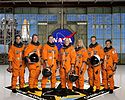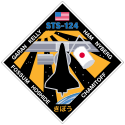STS-124
 | |
| Dane misji | |
| Indeks COSPAR | 2008-027A |
|---|---|
| Zaangażowani | |
| Oznaczenie kodowe | STS-124 |
| Pojazd | |
| Wahadłowiec | Discovery |
| Załoga | |
 Od lewej: Gregory Chamitoff, Michael E. Fossum, Kenneth Ham, Mark E. Kelly, Karen L. Nyberg, Ronald J. Garan, Akihiko Hoshide | |
| Dowódca | Mark E. Kelly |
| Start | |
| Miejsce startu | Stany Zjednoczone, KSC, LC39-A |
| Początek misji | 31 maja 2008 21:02:12 UTC |
| Orbita okołoziemska | |
| Apogeum | 351 km |
| Perygeum | 338 km |
| Okres orbitalny | 91,4 min |
| Inklinacja orbity | 51,6° |
| Lądowanie | |
| Miejsce lądowania | KSC, pas startowy 15 |
| Lądowanie | 14 czerwca 2008 15:15:17 UTC |
| Czas trwania misji | 13 dni 18 godzin 13 minut i 6 sekund |
| Przebyta odległość | 9 230 622 km (5 735 643 mile)[1] |
| Liczba okrążeń Ziemi | 217[1] |
| Program lotów wahadłowców | |
STS-124 – misja wahadłowca Discovery, trwająca od 31 maja do 14 czerwca 2008. Jej głównym celem było dostarczenie na Międzynarodową Stację Kosmiczną (ISS) kolejnych części japońskiego laboratorium Kibō – modułu Pressurized Module (który został zadokowany do Harmony) oraz manipulatora JEMRMS. Przed katastrofą Columbii, do tej misji przeznaczona była właśnie Columbia.
Był to trzydziesty piąty lot promu Discovery oraz sto dwudziesta trzecia misja programu lotów wahadłowców.
Załoga
- źródło[2]
- Mark E. Kelly (3)*, dowódca
- Kenneth Ham (1), pilot
- Karen L. Nyberg (1), specjalista misji
- Ronald J. Garan, Jr. (1), specjalista misji
- Michael E. Fossum (2), specjalista misji
- Akihiko Hoshide (1), specjalista ładunku (JAXA) (Japonia)
Odwieziony członek Ekspedycji 17
- Gregory Chamitoff (1), inżynier pokładowy ISS
Przywieziony na Ziemię członek Ekspedycji 17
- Garrett Reisman (1), inżynier pokładowy ISS
- *(liczba w nawiasie oznacza liczbę lotów odbytych przez każdego z astronautów)
Plan lotu
- 28 maja – rozpoczęcie odliczania.
- 31 maja – start z KSC.
- 2 czerwca – połączenie z ISS.
- 3 czerwca – EVA-1 (Fossum, Garan) – dołączenie JEM PM do lewego portu Harmony.
- 5 czerwca – EVA-2 (Fossum, Garan) – prace przy ISS.
- 7 czerwca – przełączenie JEM ELM-PS z górnego portu Harmony na górny port JEM PM.
- 8 czerwca – EVA-3 (Fossum, Garan) – prace przy JEM ELM-PS i JEM PM.
- 10 czerwca – odłączenie od ISS.
- 12 czerwca – lądowanie w KSC.
Rzeczywisty przebieg lotu
- źródło[3]
- 3 maja – prom wyjechał na platformę startową.
- 5 maja – w ładowni promu zamontowano moduł Kibō.
- 13-14 maja – wykonano FRR.
- 19 maja – wykonano ELR, data startu wyznaczona na 31 maja.
- 28 maja – rozpoczęto odliczanie.
- 31 maja – o godz. 21:02:12 UTC Discovery pomyślnie wystartował w kierunku ISS.
- 2 czerwca – o godz. 18:03 UTC wahadłowiec przycumował do ISS.
- 3 czerwca – spacer kosmiczny (EVA-1) (Fossum, Garan), 6 godzin 48 minut.
- 5 czerwca – EVA-2 (Fossum, Garan), 7 godzin 11 minut.
- 8 czerwca – EVA-3 (Fossum, Garan), 6 godzin 33 minuty.
- 11 czerwca – o godz. 11:42 UTC Discovery odłączył się od stacji ISS.
- 14 czerwca – 15:15 UTC orbiter wylądował na pasie startowym w Centrum Kosmiczne imienia Johna F. Kennedy’ego.
Parametry misji
- Masa:
- Perygeum: 338 km[5]
- Apogeum: 351 km[5]
- Inklinacja: 51,6°[5]
- Prędkość: ~28 000 km/h
- Okres orbitalny: 91,4 min[5]
Dokowanie do ISS
- Połączenie z ISS: 2 czerwca 18:03 UTC
- Odłączenie od ISS: 11 czerwca 11:42 UTC
- Łączny czas dokowania: 8 dni 17 godzin 39 minut
Zobacz też
- lista misji wahadłowców
- lista załogowych lotów kosmicznych do ISS
- lista bezzałogowych lotów kosmicznych do ISS
- lista załogowych lotów kosmicznych
Przypisy
- ↑ a b Adam Chen, William Wallack, George Gonzales: Celebrating 30 Years of the Space Shuttle program. NASA, 2012. ISBN 978-0-16-090202-4.
- ↑ Robert Godwin: Space Shuttle. Warszawa: Prószyński Media Sp. z o.o., 2011, s. 89, seria: Historia podboju Kosmosu. ISBN 978-83-7648-973-5.
- ↑ STS-124. Loty kosmiczne. [dostęp 2014-06-23].
- ↑ a b c STS-125 Kibo Hope For A New Era (ang.). W: STS-125 Press Kit [on-line]. NASA, maj 2008. [dostęp 2014-06-23].
- ↑ a b c d e Mark Wade: STS-124 (ang.). W: Encyclopedia Astronautica [on-line]. [dostęp 2017-07-18].
Linki zewnętrzne
- opis misji STS-124 na stronie NASA (ang.)
- Mark Wade: STS-124 (ang.). W: Encyclopedia Astronautica [on-line].
- Spaceflight mission report: STS-124 (ang.). Space Facts.
- STS-124. Loty kosmiczne.
Media użyte na tej stronie
The flag of Navassa Island is simply the United States flag. It does not have a "local" flag or "unofficial" flag; it is an uninhabited island. The version with a profile view was based on Flags of the World and as a fictional design has no status warranting a place on any Wiki. It was made up by a random person with no connection to the island, it has never flown on the island, and it has never received any sort of recognition or validation by any authority. The person quoted on that page has no authority to bestow a flag, "unofficial" or otherwise, on the island.
- ISS japanese Kibo module
- original description: In the Space Station Processing Facility, the Japanese Experiment Module (JEM) rests on a workstand during pre-assembly measurement activities. Developed by the Japan Aerospace Exploration Agency (JAXA), the JEM will enhance the unique research capabilities of the orbiting complex by providing an additional environment for astronauts to conduct science experiments.
Official crew portrait image of STS-124 space shuttle crew; From the left are astronauts Gregory E. Chamitoff, Michael E. Fossum, both STS-124 mission specialists; Kenneth T. Ham, pilot; Mark E. Kelly, commander; Karen L. Nyberg, Ronald J. Garan and Japan Aerospace Exploration Agency's (JAXA) Akihiko Hoshide, all mission specialists. Chamitoff is scheduled to join Expedition 17 as flight engineer after launching to the International Space Station on mission STS-124. The crewmembers are attired in training versions of their shuttle launch and entry suits.
Emblem of Nasa's STS-124 mission.
- The STS-124/1J patch depicts the Space Shuttle Discovery docked with the International Space Station (ISS). STS-124/1J is dedicated to delivering and installing the Japanese Experiment Module (JEM) known as Kibo (Hope) to the ISS. The significance of the mission and the Japanese contribution to the ISS is recognized by the Japanese flag depicted on the JEM Pressurized Module (JPM) and the word Kibo written in Japanese at the bottom of the patch. The view of the sun shining down upon the Earth represents the increased "hope" that the entire world will benefit from the JEM's scientific discoveries. The JPM will be the largest habitable module on the ISS and is equipped with its own airlock and robotic arm for external experiments. In addition to delivering and installing the JPM, the STS-124 crew will relocate the JEM Logistics Pressurized (JLP) module to its permanent home on the zenith side of the JPM. During three planned space walks, the crew will perform external ISS maintenance and JPM outfitting, as well as extensive robotic operations by the ISS, space shuttle, and JEM robotic arms. It will be the first time that three different robotic arms will be operated during a single space flight mission.






